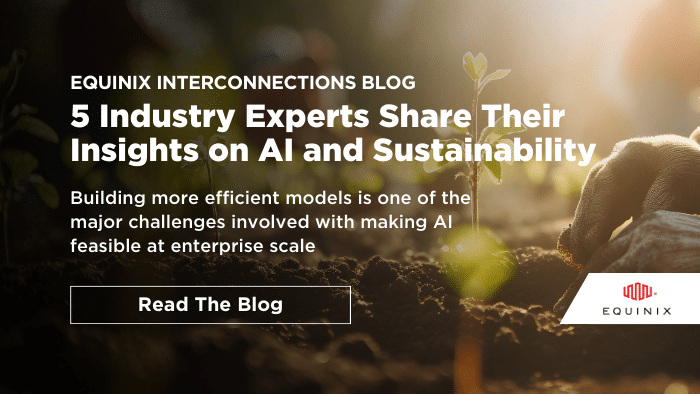[ad_1]
Sally Eaves, Principal Impact & Philanthropy Advisor, Axpire and Forbes Technology Council Member – @SallyEaves

Early detection of pollutants is key. Air purifiers with embedded AI capabilities can monitor and record environmental data, including real-time air quality. This enables agile adaption of filtration efficiency, driving multiple benefits for employee health and productivity.
Another example is the application of AI to optimize production and management of renewable energy supply and demand. The predictive capabilities of AI enable active intelligence and optimize efficiency while reducing costs and carbon waste. Advances in weather forecasting through AI are a case in point!
Jon Lin, Executive Vice President and General Manager, Data Center Services, Equinix – @JonLin

AI can generate efficiencies throughout an organization and its supply chain. Some examples:
- Insights into energy usage patterns can help businesses take advantage of off-peak hours to ease demands on the grid, while predictive weather data can help them identify the best times to leverage solar, wind and water energy resources.
- AI-generated predictive maintenance offers several layers of efficiency and sustainability, which could apply to anything from airplanes to industrial machinery to telecom infrastructure. Organizations can proactively prevent equipment failures, optimize maintenance scheduling and reduce unnecessary emergency repairs and operations.
- Carbon footprint analysis can calculate and track emissions, identifying emission hotspots and providing recommendations for greater carbon reductions. These insights help companies set and achieve goals, monitor progress and make decisions in real time.
Because these emerging technologies require a lot more energy, I’d suggest looking at their benefits juxtaposed to their carbon footprint. Ask whether it’s worth the impact on sustainability; if it appears to be creating a greater footprint than you’d like, consider the following:
- Explore ways to offset that impact by increasing renewable energy supplies.
- Establish an alternative data infrastructure that is more energy efficient using hybrid and cloud.
- Ensure you’re taking advantage of modern hardware that’s designed to handle machine learning (ML) workloads in an energy-efficient way.
- Where possible, simplify the ML models and incorporate energy efficiencies.
- Be flexible. Make real-time adjustments to maximize efficiencies and provide transparent reporting of progress toward your sustainability goals.
Matthew Sekol, Global ESG and Sustainability Industry Advocate at Microsoft – @MatthewSekol

Most companies run systems that aren’t built for reporting environmental, social and governance (ESG) data. To gain these insights, companies must modernize their core business applications and break down internal silos to understand their operations and value chain. Once those systems surface data, businesses can layer on AI to find new connections between business systems and processes. What’s interesting to consider is the work Microsoft Research is doing to uncover the balance between training AI models and sustainability, since AI can use large amounts of energy.
Meeting the energy requirements of AI and other emerging technologies is a huge challenge. Like cybersecurity, data bias, responsible AI and other foundational technology-based governance principles, sustainability is something that technology teams must consider across deployment, operations and maintenance. Educating business units about those requirements, especially as carbon accounting becomes more ubiquitous and granular, is a key activity that businesses should undertake before planning new systems.
Chris Penn, Co-Founder and Chief Data Scientist at TrustInsights.ai – @CsPenn

Energy consumption comes down to efficiency, which requires more thoughtful and careful requirement gathering. Much work is being done to take existing models and optimize them for efficiency and low-compute environments. For example, let’s look at large language models (LLMs) like GPT-4, LLaMa and PaLM 2, which power services like ChatGPT and Bard.
Until the release of Meta’s LLaMa, model-makers like OpenAI focused on bigger, more powerful models. With that focus came increasing power requirements to run them. When Meta open-sourced LLaMa, the open-source community started thinking…smaller. Could LLMs run on consumer laptops, or even a device as small as the Raspberry Pi? With techniques like low-rank adapters and quantization, open-source developers were able to dramatically shrink the size and power requirements of LLaMa-based models while trading off only a percentage point or two of accuracy.
Companies should be looking to the open-source movement as much as they can, and thinking in terms of making AI models not only effective, but as efficient as possible.
Christopher Wellise, Vice President, Global Sustainability, Equinix

AI not only provides predictive insights into the management of business operations—from energy consumption to network efficiency to application management—it can also enable other insights to support the sustainability of an organization. From predicting weather for efficient supply chain transportation routes, to identifying product/service demand analytics, to crowd-sourcing a market’s preferred car color to improve inventory management and reduce product surplus, there are several ways that AI can benefit a business.
By partnering with suppliers and businesses that have the same sustainability vision and goals, companies can reach their commitments faster while driving a sustainable ecosystem that enables greater industry impact. Companies should look to work with suppliers that are building efficient infrastructure and supplying it with green energy. Investing in renewables to drive the greening of the grid is material to supporting growing energy requirements. In addition, businesses can utilize digital services to run business operations while maximizing energy efficiency.
Get more insights from global IT leaders
Meeting sustainability targets and accelerating AI adoption are two priorities that global businesses must pursue simultaneously. However, they don’t have to be competing priorities: With the right strategy, it’s entirely possible for businesses to run their AI models in a sustainable manner, while also using the power of those models to further their sustainability efforts in other ways.
AI and sustainability are only two examples of the challenges and opportunities that IT leaders face as they prepare for the future. To learn more about some of the others—including cybersecurity threats, tech skills challenges and the rapidly evolving regulatory landscape—read the 2023 Global Tech Trends Survey from Equinix.
[1] “Air pollution,” World Health Organization.
[ad_2]
